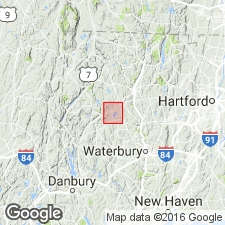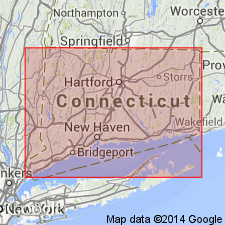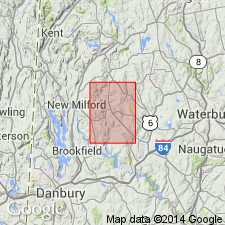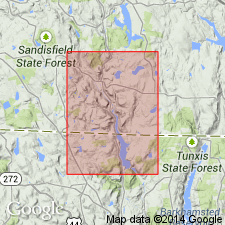
- Usage in publication:
-
- Mount Tom hornblende gneiss
- Modifications:
-
- Named
- Dominant lithology:
-
- Gneiss
- AAPG geologic province:
-
- New England province
Summary:
Mount Tom hornblende gneiss described here as the dark-green or green and white hornblende gneiss that forms Mount Tom, Little Mount Tom, and Mount Rat. Occurs as dikes in Hartland schist along northwest slope of Mount Rat.
Source: GNU records (USGS DDS-6; Reston GNULEX).

- Usage in publication:
-
- Mount Tom hornblende gneiss
- Modifications:
-
- Revised
- AAPG geologic province:
-
- New England province
Summary:
Unit assigned to Mount Prospect complex (new).
Source: GNU records (USGS DDS-6; Reston GNULEX).

- Usage in publication:
-
- Mount Tom hornblende gneiss
- Modifications:
-
- Overview
- AAPG geologic province:
-
- New England province
Summary:
The Mount Tom is dark-greenish-black or mottled black and white rock composed essentially of hornblende and plagioclase. Varies from coarse to fine grained, massive to foliated and lineated. Evidence in New Preston quad. for probable igneous origin.
Source: GNU records (USGS DDS-6; Reston GNULEX).

- Usage in publication:
-
- Mount Tom hornblende gneiss*
- Modifications:
-
- Areal extent
- Revised
- AAPG geologic province:
-
- New England province
Summary:
Mount Tom hornblende gneiss is used in this report, as it applies primarily to hornblende gneisses in general area of Litchfield, New Preston, and Roxbury quads. Forms cluster of intrusive bodies in Hartland formation.
Source: GNU records (USGS DDS-6; Reston GNULEX).

- Usage in publication:
-
- Mt. Tom Amphibolite
- Modifications:
-
- Revised
- AAPG geologic province:
-
- New England province
Summary:
Mt. Tom Amphibolite included in Hartland Group in the Bantam Lake thrust sheet, along with Litchfield Schist. Hartland Group in the Cameron's Line thrust sheet includes the Mt. Prospect [Prospect] Formation, the Mt. Rat Schist [first used] and the Bee Brook Formation [first used]. Described as dark-green to black, fine- to coarse-grained, massive, lineated, or foliated, quartz-andesine-hornblende gneiss. Age shown as Cambrian(?) and Ordovician.
Source: GNU records (USGS DDS-6; Reston GNULEX).
For more information, please contact Nancy Stamm, Geologic Names Committee Secretary.
Asterisk (*) indicates published by U.S. Geological Survey authors.
"No current usage" (†) implies that a name has been abandoned or has fallen into disuse. Former usage and, if known, replacement name given in parentheses ( ).
Slash (/) indicates name conflicts with nomenclatural guidelines (CSN, 1933; ACSN, 1961, 1970; NACSN, 1983, 2005, 2021). May be explained within brackets ([ ]).

